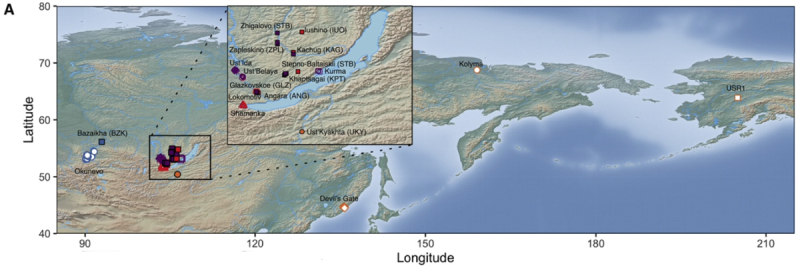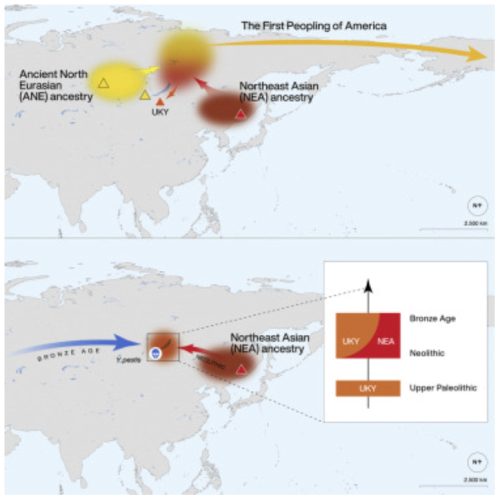The human tendency to identify with tribes of "like" humans (related by family, place of origin, or religion, among other bases) was perverted during the Twentieth Century (and in some places remains so today) into the idea of "purity" along racial lines. The foolishness of this thinking, insofar as it is based on genetic relatedness, has been debunked recently by a wealth of scientific evidence, explicated thoroughly in David Reich's book, Who We Are and How We Got Here: Ancient DNA and the New Science of the Human Past.
These researches have not reached any sort of completion, and last week, a group of authors* published a paper in Cell entitled "Paleolithic to Bronze Age Siberians Reveal Connections with First Americans and across Eurasia" which sets forth further genetic evidence of the relationship between Bronze Age Siberian populations and early North Americans (as well as evidence of Yersinia pestis co-migration with its human hosts).
Prior work had shown the existence of an Ancient North Eurasian (ANE) (24,000 yo individual) showing a genomic ancestry "widespread" across Siberia during the Paleolithic (extending until ~8,500 BCE); the contributions of this genomic pattern can be found in both present-day Eurasians and Native Americans. There is extensive genetic, anthropological, and historical evidence that Siberia was the source of multiple migrations into North America that resulted in colonization and population of both North and South American beginning 25,000 – 20,000 years ago, millennia before European colonization in the second millennium A.D. This prior work did not definitively establish the Siberian population or populations responsible for these migrations. This uncertainty is complicated by the cultural and genetic changes associated with population movements during the transition from the Neolithic to the Bronze Age, particularly from the steppes in Easter Eurasia which the authors characterize as being "largely unexplored."
Here, these researchers performed genome-wide analysis from 19 Upper Paleolithic to Early Bronze Age unrelated individuals (4 females, 15 males) from the Lake Bailal region in Siberia. In addition, analysis of Y. pestis found associated with the tested human samples, which evidence supports migration from the western steppes as contributing to these Siberian populations. These 19 samples included one from an Upper Paleolithic person (dated from 14,050-13,077 before the present day, BP); four individuals from the Early Neolithic (7,320 - 6,500 BP); and 14 late Neolithic individuals (4,830 – 3,570 BP) from ten different archeological sites:

The DNA used in these studies were from teeth and portions of temporal bone prepared as single-stranded and double-stranded libraries that were subject to shotgun sequencing. Endogenous DNA amounts ranged from 0.12-50.54%; these libraries were enriched for human DNA (there being some contaminating non-human DNA almost always in such libraries) using human-specific SNPs targeting comprising 1.24 million variable sites and then sequenced to provide 0.04X – 2.07X coverage of the human genome. "Pseudo-haploid" genotypes were determined by random sampling of a single allele at each position in the pseudo-haploid genotype, covering 34,000 – 886,000 SNPs. Further, these authors report performing "deep" shotgun sequencing of 8 individuals with "high endogenous DNA levels" (defined as 12-51%) and finally refined these individuals' diploid genotypes by comparison of 386,000 – 518,000 SNPs to the Human Origins dataset and with 3,014 modern (present day) genotypes and 453 ancient human DNA samples.
The genetic background of the individuals was assessed by Principle Component Analysis, which revealed admixture of genotypes from Northeast Asian ancestry from the Russian Far East and ANE ancestry from Upper Paleolithic Siberian individuals. Finer resolution population analysis showed that the genetic profiles of the individuals in this study comprised "a mixture of three major components that were mostly enriched in ANE-related individuals, northeast Asians, and central Siberians." There was no inbreeding found in any of these individuals, although "runs of homozygosity" analysis suggested a smaller population size in Mesolithic northeastern Siberia.
"Outgroup" statistics of the genetic information derived from these 19 individuals showed a "close genetic affinity with Native American and Beringian (i.e., from populations settled around the Bering Strait) populations," with differences most likely due to genetic drift in Native American populations from the ancestral ANE genotype. In addition, "aside from the first wave migrating into the Americas through Beringia, the admixture modeling suggests that the source of the Native American ancestry was more broadly spread across Siberia during the Upper Paleolithic." The data were also consistent with "this basal Native American group experienced multiple genetic contacts with northeast Asian populations giving rise to distinct ancient Siberian populations."
With regard to the Siberian populations per se, the results of the genetic analyses set forth in this paper suggested a more prolonged period of population mixing in the Lake Bailal area, "between local groups and northeast Asian-related populations" occurring during the early Neolithic period. And illustrating the granularity of the information that can be obtained from such studies, the authors report that one individual appears to have migrated from the Angara River Valley to the Lake Bailal region prior to being 7 years of age, based on the levels of 87Sr/86Sr in his teeth.
Turning to the evidence of Y. pestis infection and its relevance to the population studies described in this paper, the authors reference prior research results showing such infections in Europe and central Asia between the Middle Neolithic period and the Bronze Age, spanning ~4,900 – 3,500 BP. Two of the individuals (estimated to have lived 4,556 and 4,430 BP) studied by these authors had evidence of Y. pestis infection. Genetic comparisons found the most similarity to a genome from the Baltic Sea, which was anomalous because these individuals were shown to be "genetic outliers" having relatively less steppe population-derived ancestry (which had been previously associated with Y. pestis infection). The authors assert their data to provide the first "evidence for the presence of human Y. pestis infections in the Lake Baikal region during the Early Bronze Age," which is the eastern-most appearance of the disease in this time period.
The authors provide several conclusions and interpretations of this information and analysis. First, they contend that their data is evidence for "multiple population turnovers [having taken] place in the Lake Baikal region from the Upper Paleolithic to the Bronze Age periods as a dynamic variation of ANE and NEA ancestry proportions," and not a "complete replacement of the ANE-related ancestry by an East Asian gene pool," as had been previously suggested. Rather, their data is consistent with there having been "a prolonged gene flow between NEA- and ANE-related ancestries throughout the eighth to the sixth millennium BP."
Second, these genetic analyses provided evidence that non-Arctic Native Americans had a "strong genetic connection" with Upper Paleolithic Siberians, based on the genetic comparisons and similarities between "Native Americans, the 14,000-year-old southern Siberian . . . individual and the 9,800-year-old northeastern Siberian . . . individual," who appear to all have been descendants of "the same admixed population that carried both ANE and NEA ancestries [and] was likely widespread across Siberia during the Upper Paleolithic and experienced frequent genetic contacts with northeast Asian-related populations." But rather than providing a definitive source of Native American ancestry from these groups, the authors state that while "our result[s] challenges the hypothesis that this basal Native American ancestry formed in northeastern Siberia,"[f]urther genetic evidence from Upper Paleolithic Siberian groups will be necessary to describe where and when exactly the ancestral gene pool of Native Americans came together." These migrations are shown graphically in the paper:

There evidence does show, in these authors' opinion, that there was "genetic contact between southern Siberia and the western steppe during the Early Bronze Age, based on both human and pathogen DNA data, which suggests a high mobility across Eurasia." And the pathogen genetic data "may rather be indicative of a century- or decade-long process that lead to the bacterium's long-distance spread," which "most parsimoniously suggests that Y. pestis spread into this region within the context of . . . steppe expansions during the fifth millennium BP."
The authors conclude the paper by stating that:
[O]ur study describes dynamic changes in the population structure of the Lake Baikal region and reveals a widespread occurrence of the genetic ancestry that gave rise to the First People of the Americas in Upper Paleolithic Siberia. In addition, we provide evidence of high human mobility across the Eurasian steppe revealing new insights about the spread of Y. pestis during the fifth millennium BP.
* He Yu, Maria A. Spyrou, Marina Karapetian, Svetlana Shnaider, Rita Radzevičiūtė, Kathrin Nägele, Gunnar U. Neumann, Sandra Penske, Jana Zech, Mary Lucas, Petrus LeRoux, Patrick Roberts, Galina Pavlenok, Cosimo Posth, Choongwon Jeong (corresponding author), and Johannes Krause (corresponding author)
Affiliations: Max Planck Institute for Science of Human History; Siberian Branch Russian Academy of Sciences; University of Cape Town, South Africa; and Moscow State University